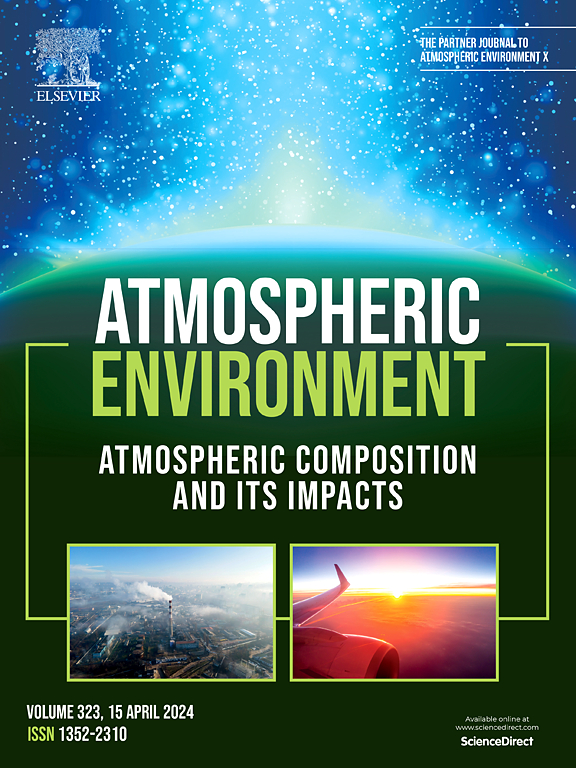Evolution of surface ozone pollution in Yangtze Rriver Delta between 2019 and 2022: influences of meteorology and emissions
IF 3.7
2区 环境科学与生态学
Q2 ENVIRONMENTAL SCIENCES
引用次数: 0
Abstract
The Yangtze River Delta (YRD) suffers severe surface ozone (O3) pollution during summer (June-July-August, JJA). Elucidating the role of meteorology and emissions is crucial for effective controls on O3 pollution. We used the Weather Research and Forecasting (WRF) - Community Multiscale Air Quality (CMAQ) modeling system to quantify the influences of meteorology, anthropogenic and biogenic emissions on O3 variations in the YRD between 2019 and 2022. Contrasting trends in surface O3 were found in the Hangzhou Bay (HZB) (3.3 μg m−3 yr−1) and the rest of the YRD (−1.9 μg m−3 yr−1). Underlying factors affecting surface O3 differed between these two subregions. In HZB, meteorological variations dominated the strong O3 increase with a contribution of ∼94 %. By contrast, in the rest of the YRD, meteorology (42 %) and anthropogenic emissions (53 %) were both key contributors to the modest O3 decrease. Our results reveal a shift in O3 drivers in contrast to 2013–2019, characterized by an increasing importance of meteorology and a decreasing contribution of anthropogenic emissions. Consequently, the anthropogenically driven O3 decrease, which ensues from current pollutant control policies, is difficult to offset the strong positive meteorological influence such as in HZB. There is an urgent need for stricter and more efficient control of O3 precursor emissions to mitigate the substantial influences of meteorology. Emissions of non-methane volatile organic compounds are of particular concern, as they are still on the rise.

2019 - 2022年长江三角洲地表臭氧污染演变:气象和排放的影响
长三角地区夏季(6 - 7 - 8月)地表臭氧污染严重。阐明气象和排放的作用对于有效控制O3污染至关重要。我们使用天气研究与预报(WRF) -社区多尺度空气质量(CMAQ)模型系统,量化了2019 - 2022年气象、人为和生物排放对长三角地区O3变化的影响。杭州湾(HZB)表层O3 (3.3 μg m−3 yr−1)与长三角其他海域表层O3 (- 1.9 μg m−3 yr−1)变化趋势相反。影响地表臭氧的潜在因素在这两个分区之间存在差异。在HZB,气象变化主导了O3的强烈增加,贡献约94%。相比之下,在长三角的其他地区,气象(42%)和人为排放(53%)都是O3适度减少的关键因素。我们的研究结果显示,与2013-2019年相比,O3驱动因素发生了变化,其特点是气象的重要性日益增加,人为排放的贡献减少。因此,目前的污染控制政策导致的人为驱动的O3减少很难抵消HZB等强烈的积极气象影响。迫切需要更严格和更有效地控制臭氧前体排放,以减轻气象的重大影响。非甲烷挥发性有机化合物的排放尤其令人担忧,因为它们仍在上升。
本文章由计算机程序翻译,如有差异,请以英文原文为准。
求助全文
约1分钟内获得全文
求助全文
来源期刊

Atmospheric Environment
环境科学-环境科学
CiteScore
9.40
自引率
8.00%
发文量
458
审稿时长
53 days
期刊介绍:
Atmospheric Environment has an open access mirror journal Atmospheric Environment: X, sharing the same aims and scope, editorial team, submission system and rigorous peer review.
Atmospheric Environment is the international journal for scientists in different disciplines related to atmospheric composition and its impacts. The journal publishes scientific articles with atmospheric relevance of emissions and depositions of gaseous and particulate compounds, chemical processes and physical effects in the atmosphere, as well as impacts of the changing atmospheric composition on human health, air quality, climate change, and ecosystems.
 求助内容:
求助内容: 应助结果提醒方式:
应助结果提醒方式:


